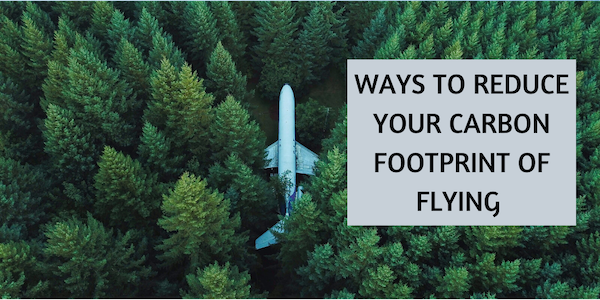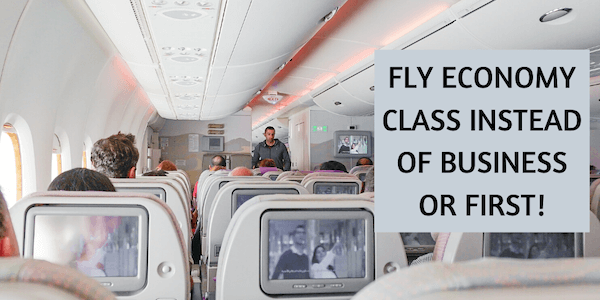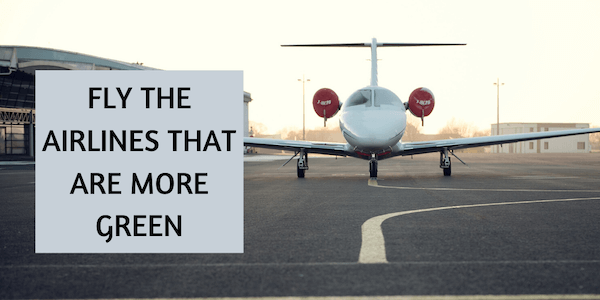How to reduce your carbon footprint of flying

More and more people are becoming aware of global warming and the part they are playing in it. This has led to an increased amount of people trying to be more environmentally friendly, in an attempt to reduce their carbon footprint of flying. But there’s no denying that it can be an overwhelming task as there are so many factors to consider, especially when it comes to flying. So we have prepared a helpful guide on what you can do to help.
A study in 2018 found that the current carbon footprint caused by global tourism is at 8%! It is predicted that tourism will play a huge part in causing greenhouse gas emissions to rise. It is calculated that aviation greenhouse gases will only increase as the demand for flying is rising with more people travelling daily.
Another report by UN shows that travelling by plane could come to produce as much as 12% of global emissions by 2050. This is even if the aviation industry manages to meet all their goals like using biofuels and improving their technology. If they fail to do that, then we are looking at carbon emissions increasing by 27%!
Check out what you can do about it below!
Fly less
In this fast-paced world with easy to access flights for a weekend getaway, we have all become too accustomed to taking flights more regularly. So flying less might seem like a really obvious one but should be one given more thought. We are yet to create carbon-neutral flights so until that happens, we should all try to take fewer flights as this will certainly help decrease your carbon footprint.
For instance, before booking a flight, really think about it and ask yourself if you really need to fly to that destination? This should be especially considered when you’re considering taking a business trip. Nowadays, a lot of travel has become business-related, with people sometimes flying for just a day!! But before flying, you should consider other options, for example, if that business meeting could be conducted online? With our technological advances, a meeting could easily take place over a Skype call, a Google Hangout, or any other online options. This is not only cost-effective but also environmentally friendly so you should definitely take this into consideration.
Consider a staycation! Instead of travelling internationally, why not travel domestically? Staycations are not only cheaper but they are also more environmentally friendly too. Not to mention, they are far less stressful because you don’t need to worry about carrying or forgetting any of the important documents or stressing about missing the flight! You simply pack some clothes, get in a car and you’re all ready for your holiday.

Try conscious flying
We know not everyone will be able to cut down on flying so if you do have to fly, consider flying in economy class. Flying in business or first-class means that you get more space per person, which also means more carbon emissions per passenger. Not to mention, there’s usually more luggage allowed in those classes which adds to the weight and overall carbon footprint of the flight.
World Bank conducted a research in 2013 in which they found that the average carbon footprint of a business class traveller was 3 times more than economy class and it was a staggering 9 times more for first-class!
This may surprise you but if you travel light, it will mean you leave a smaller carbon footprint of flying. This is because the heavier the luggage, the more fuel the plane will consume. Therefore, only take what you absolutely need and try not to take the whole house with you! Why not check out our amazing packing hacks? They will certainly help!

Consider Carbon Offsetting
So what is carbon offsetting?
It’s a scheme that lets both people and companies contribute to environmental programmes in order to balance their carbon footprint of flying. These programmes will often be based in developing countries and their main purpose is to reduce overall carbon emissions around the world. Some could involve things like investing in cleaner energy technology such as solar panels, whilst other schemes will try to plant trees so they can soak up the carbon dioxide.
Some people or companies will aim to offset their whole carbon footprint but some choose to simply neutralise their impact of one specific activity. For instance, you take a flight from London to New York and you want to ensure that you don’t have a carbon footprint of flying, you simply go to the scheme’s website, where they will have an online calculator that will tell you how much carbon is produced by the flight. You simply pay the carbon offset scheme and they will reduce the equivalent amount of carbon produced elsewhere in the world, thereby making your flight’s carbon footprint neutral.
How are carbon offset schemes calculated?
There are many systems that are available to calculate the amount you have used. The most basic one will simply use the number of miles you have travelled. However, some of the more comprehensive ones will look at what class you travelled, what kind of plane you travelled in, the fuel used, and the number of people that flew in that flight. Some go as far as checking the time of day and weather too because that has an impact on the environment too.
Should you carbon offset with your airline?
This can seem like an easy option as all you have to do is simply pay a little extra when purchasing the ticket and your airline will do the rest. Roughly a third of airlines claim to contribute to some sort of a carbon offset scheme. But how they offset can vary a lot. Some airlines may give you the option to buy it before booking but others will only let you do it afterwards, which can mean you won’t know the cost until after you have booked.
Whilst this may seem like an easy option, we recommend you always check the fine print of the airline’s scheme first. Carbon offsetting schemes are not all created equal so it’s best to do your research before picking one. Go to their website and read about it and before you buy it, ask yourself if it’s worth your money or is another scheme a better option? You could do this by looking at things like how they measure your carbon footprint of flying, will they only look at miles or do a more comprehensive check like seeing what class you travelled in? You can see what kind of projects they are funding, as well as seeing if they have credentials from verified schemes like the Gold Standard or Verified Carbon Standard.

What about offsetting directly?
If you don’t like the sound of the airline picking the scheme to contribute towards, you can always choose to offset the flight directly. This way you get more freedom to choose which scheme you want to invest in. When picking a scheme, again, have a read through it properly and see if they are certified or not. The Gold Standard is one of the biggest offset schemes that many recommend. It was established in 2003 by the World Wide Fund for Nature and other different environmentalist groups and NGOs. Their projects aim to help people in developing countries as well as reducing overall carbon emissions.
What are some of the pros of carbon offsetting?
- It is easy to invest in these schemes and can make it easier on your conscience. For instance, it’s far easier to invest in a carbon offset scheme that you know will be reducing your carbon footprint than trying not to use your car for work. Whilst you should absolutely try to take the bus, or the train, for some people, it is simply not possible so this is a good way to ensure you are at least neutralising your carbon footprint.
- It helps the expansion of renewable energy sources! This is because most of these schemes will contribute towards providing money for building solar panels and wind turbines, as well as money going towards researching new technologies to help the environment. The money going into these projects means they can now be done at a much faster rate. Not to mention, most of these schemes will try to get these renewable energy sources to developing countries where it will help the local people too!
- This means that businesses are more aware of their carbon footprint. For instance, airlines will now be more conscious and by contributing towards these schemes, they are at least trying to minimise their impact on the environment. Whilst, it doesn’t mean that the gases are not being produced, it does mean that they are at least being reduced or naturalised too. As the saying goes, something is better than nothing!
- It tells us about the actual damage caused by the greenhouse gases so far. This means that the government can then use this data to and more accurately set a budget for carbon-neutral projects.
What are some of the cons of carbon offsetting?
- It can make companies and people lazy as they will simply pay to carbon offset without actually changing their flying habits. It also means that you are becoming dependent on the scheme. Whilst the schemes are really good, you should try to play your part too and not let someone else simply take responsibility.
- It should be remembered, that this will only neutralise, not reduce your carbon footprint of flying. In order to reach zero carbon footprint, we need to make conscious decisions too like flying less or taking shorter flights.
- Offset schemes like planting trees can be risky because there’s no assurance that the trees will survive long enough to actually soak in the carbon dioxide. Schemes should be researched carefully to ensure that you are making the most of your contribution.

Try alternatives modes of transport
Carbon Footprint of flying vs. train
Whilst carbon offsetting is good, the best way to reduce your carbon footprint is by trying to avoid flying. For instance, why not take the train instead if you’re only going within Europe? According to EcoPassanger if you flew from London to Madrid, you’d be emitting 118kg of carbon dioxide per person whereas if you took the train, you’d be emitting 43kg per person. We can already see the difference is huge!
However, it does depend on the type of train too because an electric train’s carbon emission is tested by seeing how the electricity is generated. But a diesel train’s emission can be twice as much as an electric train!
In order to make sure the trains are more eco-friendly, try to see where the source of electricity for the train is coming from. For example, in France, 75% of their electricity is generated from renewable energy sources like nuclear power, but if compared with Poland, 80% of their electricity comes from coal. So if you take a train from Paris to Bordeaux, it will emit 4.4kg of Co2 per person but if you travelled the same distance from Gdansk to Katowice, it will emit 61.8kg of Co2 per person!
So whilst getting the train is still a better option than flying, do try to see which type of train you take to ensure you maximise your carbon footprint reduction. You can use Eco Passeneger’s calculator to find out the difference for your journey too!

Carbon Footprint of Driving vs. Flying
Driving will be especially good for the environment if it’s electric but even if it runs on diesel or petrol, it is still a better option compared to flying! However, do remember, it’s not simply that cars are better, there are other factors to take into account. For instance, if you’re driving from London to Madrid but you’re going by yourself, then you’re producing more carbon emission than if you were to fly there. But if there’s more than one person then the car is the better option. So if you do want to travel by car, make sure the car is full or there’s at least two of you because this way you’ll actually be having an impact.

Take the green airlines
Like mentioned earlier, if you must travel, try to take more steps to make that more environmentally friendly. For instance, you can take eco-friendly flights! Below we’ll list the top 5 environmentally friendly airlines!
Alaska Airlines
- They have been very open about their Co2 emission and what they can do to improve the environment and reduce their carbon footprint.
- They have always used innovative approaches to combat this issue and some of these initiatives have been going strawless, composting ground from the coffee that’s been served on the flight, and using avionics (electric equipment onboard) to use the ‘Greener Skies’ method in an attempt to reduce their fuel consumption.
- What does this mean? Well, this method means that the aircraft will use satellite-based technology that will ensure the plane lands more efficiently and thereby uses less fuel. This approach can cut down carbon emission by nearly 35% and would burn 2.1 million fewer gallons of fuel!
Delta Airlines
- They are trying to cut down on their fuel consumption, as well as water waste and putting recycling programmes in practice.
- The airline is also known to invest in carbon offsets, in 2017 alone, they contributed $2.5 million!
- They have also created an app which can predict how the weather will be, meaning that the pilots know which weather will be less fuel consuming.
- In 2019, Earth Day, Delta made it clear that they will continue to invest in carbon offsetting, they did this by buying roughly 50, 000 carbon offsets. On a rough estimate, this will offset the carbon emission of nearly 300, 000 people!
- If this wasn’t enough, they plan to remove all single-use plastic from their flight. They have estimated that they will remove around 300, 000 pounds worth of plastic each year.
- Just recently, they have pledged a whopping $1 billion in order to become the first globally carbon-neutral airline! This is a 10-year plan that will aim to remove all emissions caused by the airline, both in air and on the ground!
American Airlines
- They are trying to invest in getting newer planes, planes that are more modern and energy-efficient. This could be that they get completely new planes or if the plane is not old enough, they will try to upgrade it to a more eco-friendly standard.
- The airline is also looking at some of the other ways it can reduce its carbon footprint of flying, some of those include having winglets to the wing weight. Winglets mean that the plane will need less fuel from the engine which will result in less carbon emission. They are also looking at going paperless and shaving weight on the plane, making it lighter and better for the environment.

KLM
- This is the world’s oldest airline, operating since 1919! But it also managed to stay one of the most sustainable airlines for 12 years now!
- Their CO2ZERO programme intends to massively reduce the CO2 produced by the airline. In this programme, you contribute towards the CO2OL Tropical Mix reforestation scheme in Panama by KLM. Around 88,000 people have used this service since 2018!
- They also have a keep cool scheme, this means that they cold-spray their jet engines in flight. Thereby turning the temperature down, which causes far less fuel to be burned.
- They have even got a programme called ‘Fly Responsibly’ in which they actually encourage people to fly less! They ask people to consider if they really need to take that flight before booking it.
JetBlue
- They are committed to protecting the environment and making sure they reduce their carbon footprint of flying.
- In 2013, they introduced their recycling programme, as well as partnering up with Dunkin’ Donuts, Jamba Juice and Royal Waste Services to compost the wasted food at JFK Airport’s Terminal 5.
- They also built the world’s first potato farm at an airport! This was built at New York’s JFK airport.
Stay in Green accommodations
Now that you’ve taken steps to be more environmentally friendly, why not make sure you stay in a green hotel too? This will ensure that your whole trip is eco-friendly! These hotels have usually taken measures that ensure their guests have a good time, as well as minimising their impact on the world by reducing waste and toxicity in their hotels.
What are some of the features of a green hotel?
- They will usually have low flow toilets and showerheads
- Will use water recycling such as using greywater which is water that comes from kitchens, bathrooms and laundry rooms
- The hotel will only use LED light bulbs
- The windows will be energy efficient to improve insulation
- Renewable energy sources such as solar panels will be used to power the property
- The food will usually be provided by the local farmers
- Recycled material is used to make the flooring or some of the building work
Non-smoking policies - All rooms will have recycling bins
- Larger bottles of soap and toiletries are provided to guests instead of individually packaged ones, in order to cut down the waste
- Transport will use renewable energy such as electric cars or bikes
So next time you book a hotel, make sure you go green! If you’re struggling to find which hotel is green, simply see if the hotel has been given the green key which is basically a credentials to say the accommodation is eco-friendly.

Things to consider next time you fly
- Ask yourself if the trip is really necessary? Can it be avoided? But if you must fly, book economy and pack light!
- Consider carbon offsetting your flight to neutralise the impact of your flight on the environment. But remember to read the scheme’s policies before you contribute to ensure your money is going to the right place
- If you’re only going within Europe, why not take the scenic route and go by train? It’s better for the environment!
- Alternatively, if you don’t like the sound of the train, why not take a road trip instead?
- However, if flying cannot be avoided, consider taking some the green airlines like KLM or Delta Airlines.
- Lastly, once you’ve reached your destination, stay in eco-friendly accommodation. You can find this out by looking if the place has been given the green key!
We hope this helps you make more eco-friendly choices! Remember to make a conscious decision to be more eco-friendly and you’ll help the environment, even if it seems something small like packing lighter when travelling by plane!